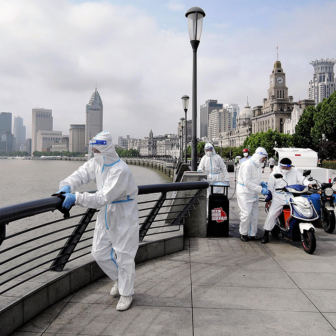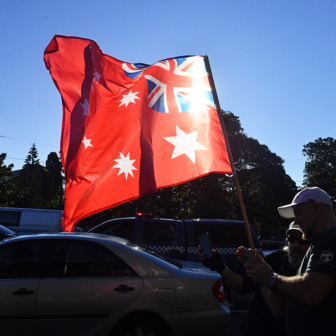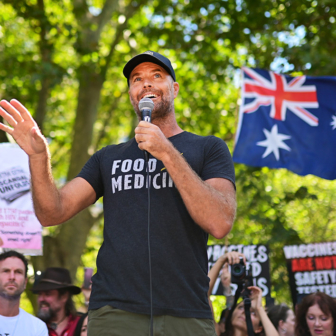After a delay of more than two weeks — almost certainly due to internal wrangling over politics and positioning — the World Health Organization finally released its expert report on the origins of Covid-19 last week. Already, though, the report’s findings and their implications are being ignored in favour of the political jousting, sniping and scientific innuendo that have prevailed through much of the pandemic.
The report deals with four possible ways the SARS-CoV-2 virus might have emerged and infected people in Wuhan. Its “likely to very likely” scenario is that the virus was transmitted to humans from an original source (almost certainly bats) by an intermediate animal host. Direct transmission from the primary animal source (referred to as zoonotic spillover) is “possible to likely.” A “possible” route would have involved transmission via frozen foods — viable viruses can be carried long distances on frozen food packaging — but an escape of the virus after a laboratory incident is seen as “extremely unlikely.”
While political sensitivities help explain the report’s tentative language, scientists, epidemiologists and public health officials weren’t surprised by its inconclusive findings. Making definitive judgements on this sort of question is never easy. AIDS, for instance, was first identified in the 1980s in the United States but it was not until 1999 that researchers could say for certain that the causative virus, HIV, originated from the simian immunodeficiency virus in monkeys, with chimpanzees as the intermediate hosts.
Even with advances in genomics since then, it would be unusual for a report twelve months into a pandemic to provide answers to all the key scientific questions. The team that produced the WHO report describe it as “a first start” and “not a static product but a dynamic one.”
The report’s first scenario reflects the generally shared view of infectious disease experts. The same route was followed by the coronavirus that caused SARS in 2002 (from bats to human, probably via raccoon dogs or civets) and Middle East respiratory syndrome in 2012 (where the likely intermediary was camels).
Although the first official case of what came to be called Covid-19 was recorded in Wuhan on 8 December 2020, it wasn’t until 21 January that Chinese authorities conceded the disease could spread by human-to-human transmission. The standard international response to an emerging public health problem, under the auspices of the WHO, was perhaps slow to get under way, but by late February 2020 the organisation had issued the report of a joint mission with China. Its goal was to underpin pandemic planning in China and internationally. The following month a brief report summarised what was then known about the origins of SARS-CoV-2 from an ongoing global study coordinated by the WHO, and the WHO also made recommendations to reduce the risk of other pathogens emerging from animals to humans in markets like Wuhan’s.
Then Donald Trump intervened, and everything became much more chaotic and increasingly driven by politics rather than science.
With a tweet on 16 March, Trump began referring to the coronavirus as the “Chinese virus.” His initial attack reportedly came after a Chinese foreign ministry spokesperson speculated that the American military personnel who attended the Military World Games in Wuhan in October 2019 could have introduced the virus.
The rhetoric quickly escalated. Soon Trump and the American right-wing media were repeatedly blaming China for the contagion, stating that it could have done more to prevent the disease spreading and proposing that the source of the virus might be a Wuhan research laboratory. As a counter, China suggested that the virus existed abroad before it was discovered in Wuhan and may have been imported into the country on or in frozen foods.
Trump also conflated blaming China with his hostility towards the WHO. He had already acted to withdraw the United States from the organisation and he now claimed the organisation had an “alarming lack of independence” from China.
Australia was drawn into the political fray in April when prime minister Scott Morrison put forward a three-point plan for overhauling the WHO: redefining its formal powers; recruiting independent investigators who would determine the source of major outbreaks like the current pandemic; and creating an independent review body to examine the performance of the WHO during such crises. Predictably outraged, the Chinese government accused Australia of launching a political attack on China and “pandering” to the United States. The furious backlash included a series of attacks on Australian exports.
Morrison wasn’t necessarily doing Trump’s bidding, but his efforts implicitly acknowledged that broad international support for a US-led inquiry was highly unlikely. As it turned out, Australia’s chances weren’t much better, although Morrison has sold the outcome as a win. Despite some heavy lobbying by Morrison, foreign minister Marise Payne, and Australia’s WHO representative Lisa Studdert, Australia’s plans were ultimately watered down considerably by the World Health Assembly, the WHO’s decision-making body.
The compromise was found in a motion from the European Union that called only for an “evaluation” of the outbreak by one of the WHO’s internal independent review committees. The motion — passed in May by the World Health Assembly with 137 votes, including from China, the United States and Australia — made no specific mention of China and provided no new powers for the WHO.
Enter the WHO origins study, whose delayed report was released last week. This is a separate process from the arm’s-length independent evaluation panel, chaired by former New Zealand prime minister Helen Clark and former Liberian president Ellen Johnson Sirleaf, which will report to the World Health Assembly, the WHO’s governing body, at its May session.
It wasn’t until November that Beijing and the WHO agreed on a series of scientific studies to be carried out in China. (These, together with the composition of the study team, were promptly rejected by the Trump administration.) The two primary aims were to determine exactly when the outbreak started and to learn how it emerged and jumped into the human population. Three types of data would be vital: genetic sequences of the virus, tests on animals, and epidemiological research into the earliest cases.
When the foreign members of the investigative team visited Wuhan in January through February, it was to help in a joint assessment of the evidence that China had found, not to scour the city for new facts. Indeed, the foreigners weren’t free to wander. While they were able to visit all the places they had requested, each visit was carefully managed. One WHO team member called the Wuhan trip a “highly chaperoned, highly curated study tour.”
Partly as a result, the report leaves unanswered a number of questions — some of them contentious — and raises other issues that need to be tackled. Where, for instance, are the bat population that harboured the progenitor of the SARS-CoV-2 virus and the intermediate host/s and what was the conduit of the virus to Wuhan? A coronavirus very similar to SARS-CoV-2 is found in the horseshoe bats that live in caves hundreds of kilometres from Wuhan, but these bat viruses don’t have a specific binding domain that would enable the spike protein to attach to a receptor on human cells, thus initiating the disease process. The important binding domain is believed to have emerged in the intermediate host. Scientists have so far tested more than 50,000 samples from domestic, farm and wild animals in the Wuhan region looking for potential intermediate hosts, and have found no trace of the virus that causes Covid-19.
Much more work is needed to explore the possibility that animal-breeding farms in southern China may be disease reservoirs. Once heavily promoted by the government, many or most of the wildlife farms appear to have been shut down in February 2020 — a strong signal that Chinese authorities considered them a probable pathway for a coronavirus to reach humans. While SARS-CoV-2 has been found in domestic cats, dogs and ferrets, in captive lions and tigers, and in farmed mink in Europe, this is a result of transmission from humans, known as reverse zoonosis. But mink, fox and raccoon dog are raised for fur in China and have not yet been eliminated as intermediate hosts.
The investigative team called for more studies of the possible role of frozen wildlife in viral transmission, and whether and how people can be infected through this route. It also recommended broadening the search for the virus’s origin beyond China. Recent reports of coronaviruses closely related to SARS-CoV-2 being found in bats in Japan, Cambodia and Thailand would justify this move, according to scientists.
The Chinese members of the team appeared to strongly favour the hypothesis that the virus could have reached Wuhan on a frozen food shipment — the third of the WHO report’s scenarios — especially if this indicated that the virus came from outside China. China has tested 1.5 million frozen samples and found the virus thirty times, so this scenario can’t yet be ruled out.
Of course, where a disease is first reported isn’t necessarily where it started. Recent evidence suggests that the first case of Covid-19 in Hubei province can be tracked back to 17 November 2019, and that by 20 December sixty cases had been confirmed. If this is correct, then either those cases were not detected or recognised at the time, or they were detected and recognised but reporting was suppressed.
Genetic evidence supports this timeline. Using molecular dating tools and epidemiological modelling, scientists estimate that the virus was circulating for about two months prior to December 2019. Add to that the growing evidence that the Wuhan market, while it may have harboured a viral “superspreader,” was not the source of infection.
Efforts in Wuhan and nearby areas to track down the earliest cases should continue, the WHO team said, to help researchers understand how the pandemic started. It recommended analysing older samples from blood banks in the province, though it isn’t clear who would provide the required technology, staffing and funding to undertake this effort.
The fourth of the WHO scenarios — a laboratory release, accidental or deliberate — may be unlikely but is still being propagated by the likes of former US secretary of state Mike Pompeo and, surprisingly, even the former head of the US Centers for Disease Control and Prevention. Until this possibility can be definitively dismissed, it will continue to undermine relations between China and countries like Australia and the United States.
The Wuhan Institute of Virology has certainly analysed bat viruses, and it does possess gene information about coronaviruses that it has not released publicly. China has a history of disinformation and delays in reporting about SARS-CoV-2 that serve to heighten suspicions. And laboratory accidents and safety lapses do happen. In an open letter published in the Wall Street Journal and Le Monde in March, a group of scientists argued that flaws in the joint WHO–China inquiry meant it couldn’t adequately explore the possibility the virus leaked from a laboratory.
Ironically, the Trump administration last May pulled the funding provided through the National Institutes of Health for a decade-old joint research alliance between American scientists and Chinese scientists at the Wuhan Institute of Virology, which was studying coronaviruses in bats and their spillover into humans. The consequent loss of trust and access was surely a hindrance to the WHO inquiry just a few months later.
Almost immediately after the report’s release, a number of countries expressed deep concerns about the adequacy of the findings. In a joint statement, Australia, the United States and twelve other countries said that the WHO team hadn’t had access to all the information it needed in China. White House press secretary Jen Psaki said that President Biden believes Americans “deserve better information” about the origin of Covid-19. The WHO report “doesn’t lead us to any closer of an understanding or greater knowledge than we had six to nine months ago about the origin,” she added. “It also doesn’t provide us guidelines or steps on how we should prevent this from happening in the future.”
Perhaps it was these concerns that prompted the WHO director-general Tedros Adhanom to remark during a briefing to member states that the report hadn’t made an “extensive enough” assessment of the possibility the virus was introduced to humans through a laboratory incident. Further data and studies will be needed to reach more robust conclusions, he said, adding that he expected “future collaborative studies to include more timely and comprehensive data sharing.”
The key participants must ultimately acknowledge that the point of these investigations is not geopolitical advantage but a better understanding of how the SARS-CoV-2 virus came to be so damaging. Despite what Trump and perhaps other leaders think, the aim of such investigations is not to apportion blame; if this becomes the key driver, they will never succeed.
Dominic Dwyer, an Australian infectious diseases expert who was part of the team that went to Wuhan, made the point well when he said, “Rather than blaming governments, we need to foster cooperation and trust between investigators, between and within countries. This not only helps us during this pandemic; it’s the key to managing future pandemics. The more cooperative we are, the more likely we are to get the best results. We have to make sure politics doesn’t muck that up.” •
Funding for this article from the Copyright Agency’s Cultural Fund is gratefully acknowledged.





